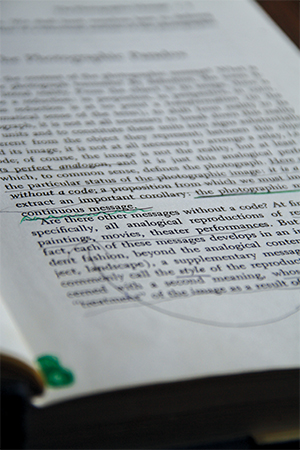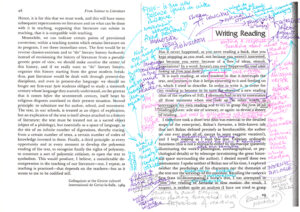
Sharing Reading Strategies
This post has developed out of conversations which were part of the Creative Arts group work sessions last year. These were exploring a range of approaches to combining practice and research. This got me thinking about reading and how it can underpin practice based research and so it would be useful to share some tips on developing reading habits as part of our practice.
As Creative Arts students studying across a range of disciplines why and how do we read? For enjoyment? To discover new ideas? To learn or develop our understanding? To develop our practice?
During my study and research journey I read to develop better writing skills (picking up good habits and a more technical vocabulary). I read for research — to both widen and deepen my knowledge. I read to acquire material to write about, to express my opinions about, and to develop new ideas building on what others had already written, whether in relation to theory or practice.

But, I am a slow reader, and generally a forgetful reader. Over the years I have been easily overwhelmed by the pile of books I have selected, and daunted by the lengthy suggested reading lists.
In overcoming these issues I have acquired strategies which have helped me to become a more effective reader. To do this, I have developed methods of an active reader. Becoming an active reader involves shifting the process of understanding—from finding out what the writer thinks about the subject, to developing what you think. It is about finding habits that help you to develop a deeper understanding of what you are reading, in order to express your own thinking more clearly.
Here are some practical tips I have found useful over the years:
- Don’t be afraid to dip into books, you don’t need to read every single book from cover to cover.
- Pick out chapters with interesting or relevant titles.
- Read the introduction and conclusion.
- If you are searching for journals, carefully read the abstract (as this will give you a good idea of whether underneath the seemingly relevant title this article is actually what you are looking for).
- Keep a glossary. No matter where you are in your study journey, there will always be words that need looking up and unpicking to enable a closer understanding of the text. Add these to a glossary to help you remember them and increase your own use of them. Eventually your glossary will develop into a list of terms that underpin your research with an explanation of how you are understanding and using them.
- Keep an annotated version of your Bibliography or any wider reading on your blog. Write a brief summary of each text, as well as noting down useful quotes with page numbers — this makes the process more useful in the long run.
- When you find a really useful or interesting paragraph in a text, go back to it and make a close reading of it. I like to photocopy book pages so I can really annotate the pages (Article Link).
I have also found the active reading method of SQR3 useful. This stands for: Survey, Question, Read, Recall, Review. See here for more information.
The most surprising thing I discovered about active reading is the number of times the text is revisited in order to develop a deeper understanding. This helped me worry less about quantity and to engage at a deeper level with the books I was reading. As Vladimir Nabokov wrote: ‘an active and creative reader is a re-reader’.
|
|






